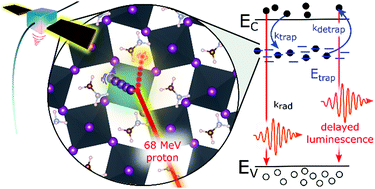Efficient minority carrier detrapping mediating the radiation hardness of triple-cation perovskite solar cells under proton irradiation†
Abstract
Highly efficient perovskite based solar cells have the potential to be a game-changing solar array technology for space applications that can be flexible, truly roll-able, ultra-lightweight and highly stowable. Outside earth's magnetic field, however, ionizing radiation causes localized defect states that accumulate and ultimately cause the failure of electronic devices. This study, assesses the radiation hardness of the widely used triple cation based perovskite absorber material, namely Cs0.05MA0.17FA0.83Pb(I0.83Br0.17)3 employing 20 and 68 MeV proton irradiation. Therefore, in situ measurements of the degradation of the proton induced current as well as the photovoltaic performance during proton irradiation are used as two independent metrics. Both measurements suggest that triple cation perovskites even exceed the radiation hardness of SiC, which is a material often proposed to possess an excellent radiation hardness. Our optimized Cs0.05MA0.17FA0.83Pb(I0.83Br0.17)3 based space solar cells reach efficiencies of 18.8% under AM0 illumination and maintain 95% of their initial efficiency even after irradiation with protons at an energy 68 MeV and a total dose of 1012 p per cm2. Degradation under 20 MeV proton irradiation is even lower. Despite the negligible impact on solar cell device performance, this study identifies that proton irradiation is changing the recombination kinetics under low excitation densities profoundly. Dark capacitance–voltage and current–voltage characteristics, photoluminescence spectra as well as photoluminescence and Voc decays are analyzed in depth. Surprisingly, two fold prolonged PL and Voc decay times are observed after proton irradiation. Often, such prolongations are attributed to a reduced charge recombination. Our kinetic model, precisely describing the observed time evolution after photoexcitation, however, establishes the prolonged release of trapped minority charge carriers from proton-radiation induced trap states.



 Please wait while we load your content...
Please wait while we load your content...